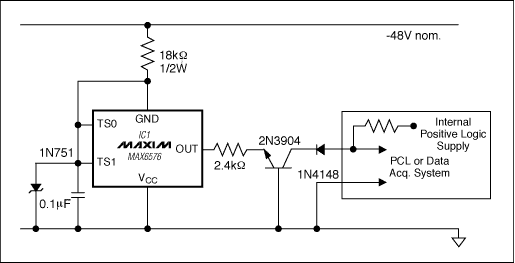Integrated-circuit temperature sensors are generally preferred in data-acquisiTIon systems for which the accuracy demands are not extreme. Sensor, signal-processing, and data-conversion electronics, plus an easy-to-use digital-I/O interface are all integrated in the temperature sensor IC, and all at low cost. Such ICs require a supply voltage in the range +3V to +5V, negaTIve to common, and they usually draw very low supply current.
Biasing the sensor is more difficult in a telecomm system, however, where the only supply voltage available is usually the -48V systems bus. If no other posiTIve low-voltage supply is available, the design must normally include a DC-DC converter powered from -48V.
The circuit of Figure 1 solves the above problem without needing an extra power supply. This circuit allows the IC sensor to operate from -48V. With the addition of a few components, it also serves as an interface to the digital inputs of programmable-logic controllers (PLCs) or other digital I/O that require logic signals ranging from 0V to some positive level. As shown here, the output can sink up to 1.6mA, and swing from 0V to about +40V (the maximum VCE for a 2N3904 transistor). That capability meets the requirements for digital I/O in most industrial systems (+15 or +5V).

Figure 1. The components shown enable this temperature-to-period converter (IC1) to interface with standard industrial logic levels while operating on a -48V telecomm systems bus.
The circuit in Figure 1 includes an absolute temperature-to-period converter (IC1). Connected as shown, it provides a conversion constant of 640µs/°K. (At room temperature the period is about 190ms, giving a frequency of 5.2Hz.) This scheme can also accommodate similar sensors, such as temperature-to-frequency converters. For a listing of accuracy specifications and other parameters associated with IC1, please see the MAX6576 data sheet.
This design idea appeared in the February 16, 2006 issue of ED.